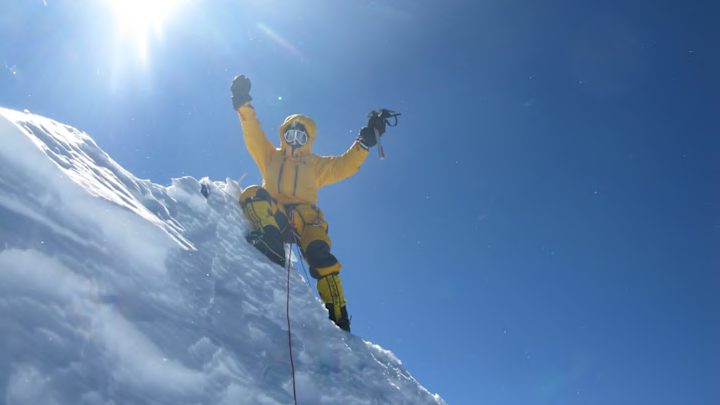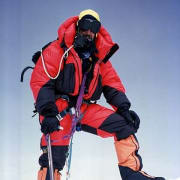Remembering a Dramatic and Selfless Rescue on Mt. Everest

I recently wrote an article on this fall’s Himalayan climbing season specific to Manaslu, as endurance athlete Tyler Andrews recently broke the speed record to the summit of the eighth highest mountain in the world. When researching this impressive feat, I also learned that legendary alpinist Simone Mora, has set his sights on an ‘Alpine-Style’ ‘Winter Climb’ on Manaslu in December - the most treacherous and difficult time of year in the Himalaya, and something never before accomplished. (Related Article on Tyler Andrews and Simone Mora on Manaslu)
Realizing the great Simone Mora continues to climb big mountains, with such lofty aspirations, warmed my heart. Simone is my hero. I met Simone Mora while climbing Mt. Everest in 2001. At base camp on Mt. Everest, Simone’s charming and enthusiastic attitude lightened the spirits of climbers taking on the enormous task of climbing the world’s tallest mountain. I enjoyed his company and looked forward to rest periods at base camp while chatting about his experiences and goals over tea.
His goals that year bordered on crazy and inspirational. He planned to climb Lhotse from the south side (Nepal), descend to base camp (Lhotse and Everest share a common base camp), rest, and then climb Mt. Everest and descend from the summit via the north side of the mountain into Tibet. While achievable for such an accomplishment mountaineer, such a journey into Tibet without a permit would result in his probable arrest and detainment by the Chinese. Mora simply laughed at the warning, assuring us that his journey would conclude with acceptance and joy on the Tibetan end. We would never learn the outcome, one way or the other, as his outrageous and inspirational plans were derailed in 2001 by a much higher calling.
Mt. Everest is the tallest mountain in the world, standing 29,029 feet. Lhotse is the 4th highest mountain in the world, standing 27,940 feet. Connected to Everest by the South Col, Lhotse's summit lies to the south, while its subsidiary peak, Lhotse Shar, extends to the east. The Lhotse Face is a steep and icy incline that poses a significant challenge for climbers attempting to reach the summits of both Everest and Lhotse. It was here that an imminent tragedy appeared to be unfolding.
A 19-year-old British climber, after successfully summiting Lhotse, navigated fix ropes descending toward high camp at 25,900 feet. The young climber, somehow separated from his team, failed to securely clip into the rope and tumbled down the mountain. Miraculously, he arrested his fall just below the altitude of Lhotse’s high camp, but off the route and on the other side a rugged rock formation known as the ‘Turtle’. Camps on Lhotse and neighboring Everest were notified, and rescue efforts developed – to no avail.
Mountaineers attempting Everest and Lhotse share the first four camp locations through Camp III. The fallen climber was below both Lhotse and Everest’s high camps, and well above Camp III at 23,294 feet. All climbing teams high on the mountains were on their final summit pushes on both peaks - meaning they were focused on their own summits, not a rescue. Teams that could get to the fallen climber fastest would come from one of the high camps – Everest Camp IV at 26,000 ft., or Lhotse Camp IV at 25,900 ft. But no one volunteered – silence.
If a climber embarked on a rescue at those altitudes, just hours from their own planned departure to the summit of two of the highest mountains in the world, their dreams and goals would die. The effort required to reach and retrieve a climber would completely deplete their reserves. They trained for years for this moment - their final push to accomplish a rare feat. It often didn’t matter if that meant someone else could actually die.
My team was located at Camp II, 21,000 ft., too far away to help the stranded climber. The picture below shows several climbers looking up the Lhotse face where the climber laid – a mere black dot in our binoculars. We were trying to mobilize a rescue, but to no avail. Until a climber responded to our radio calls, it was Simone Mora. Settled in at high camp on the Lhotse Face, Simone was almost half-way to achieving his goal of climbing both Lhotse and Everest. He had heard of the dire scenario, and the location of the climber. I will never forget his voice and message, “Do not worry, I will get him.”
We watched through our binoculars as a black dot emerged from his tent and started walking. Astonishingly, Simone did not follow the fixed ropes, a climber's lifeline, but rather took a direct route to the climber directly through the Turtle – a jagged morass of rock and ice. He was free climbing. If he fell, he would die. After more than an hour of climbing, Simone emerged from the Turtle and climbed to the seemingly lifeless climber. At that point we radioed Simone and asked about the young climber’s condition.
"He is ok, though he has lost a crampon. But do not worry, I will teach him to climb with one.”
Simone thought the safest rescue route was back up to Lhotse high camp. As darkness descended on the Himalaya, we witnessed two black dots disappear into the safety of a tent.
We congratulated Simone, and asked him how he was doing. “Well, he said, I would rather be with the friends I met in Lukla, but I am fine.”
Simone Mora’s grand plans came to end after his heroic act. He descended the next day to base camp, and later left the mountain to return home. There would more mountains, and other days to climb. He was needed and he responded – a selfless hero who truly saved a life. The young climber was assisted off the mountain to the safety of base camp.
For him, there would also be more mountains, and other days to climb – thanks to Simone Mora. Thanks Simone, for showing that climbing, humanity and compassion are not mutually exclusive.
